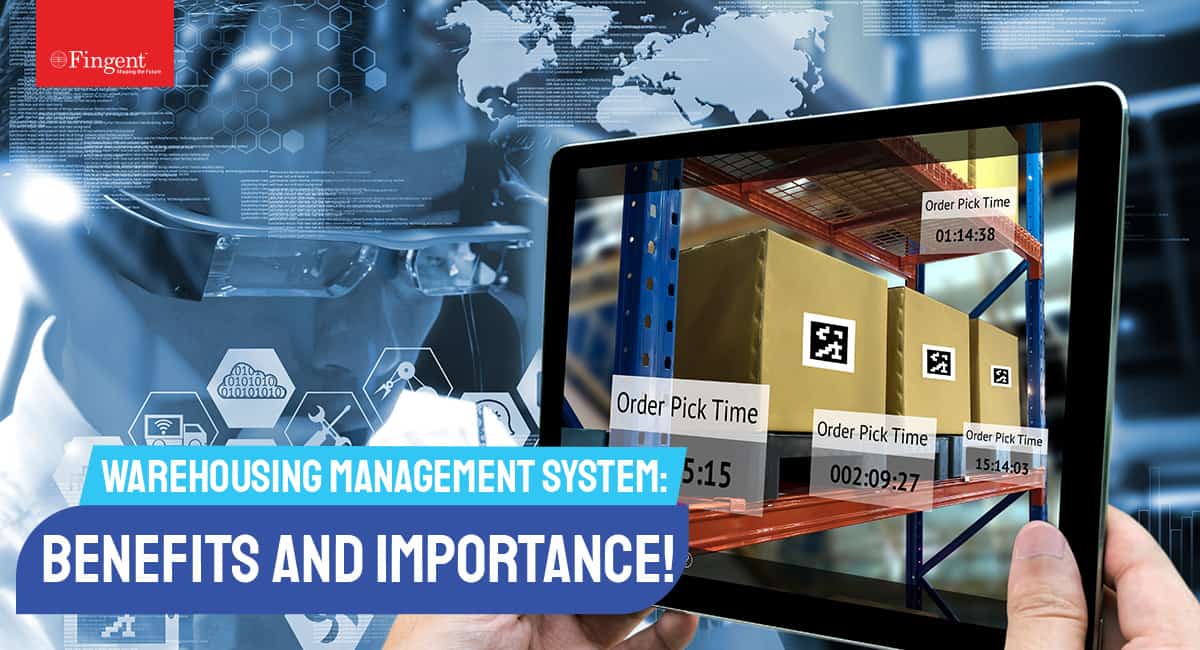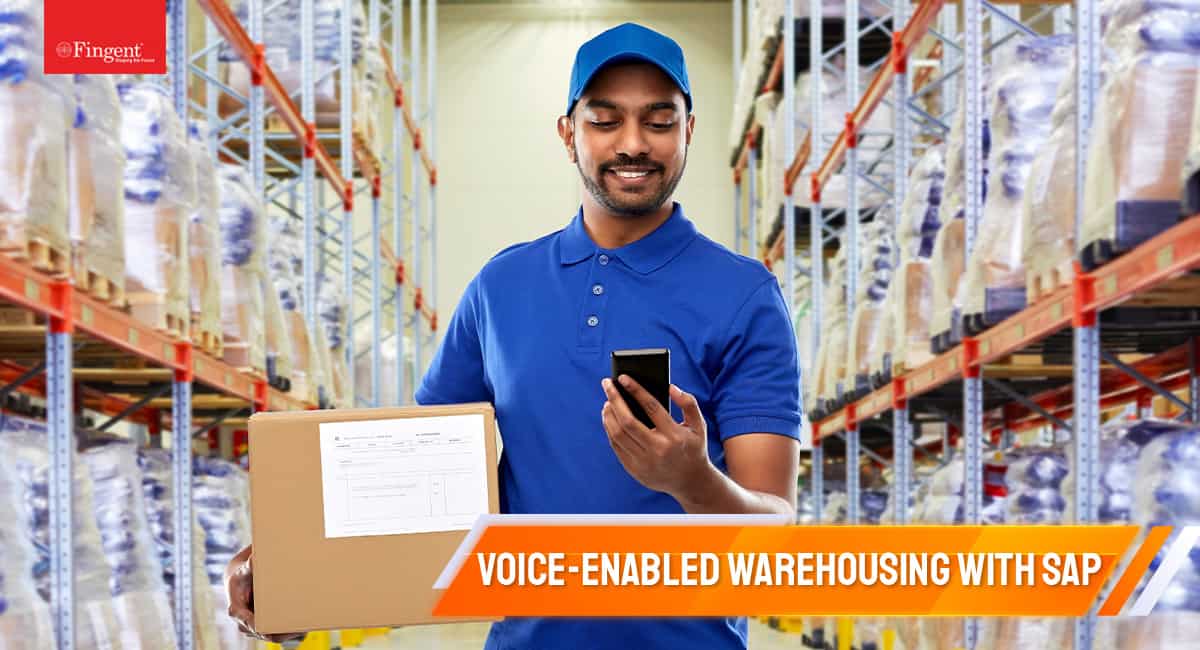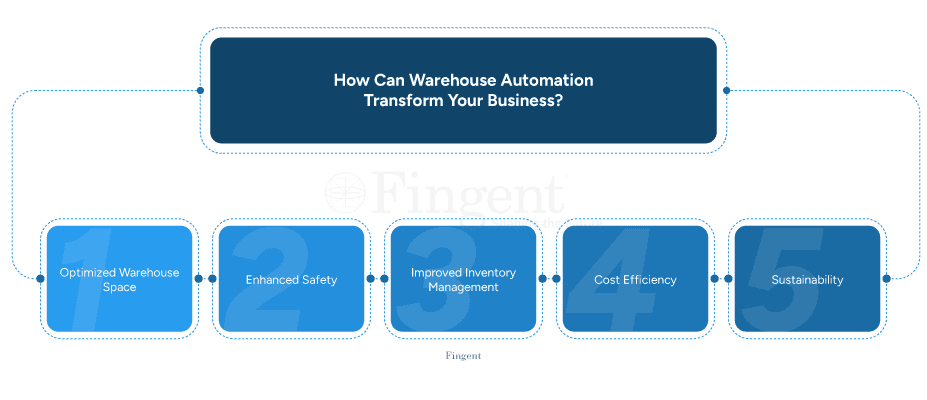Warehouse Automation: Streamlining Operations and Reducing Labor Costs
Robots in Warehouses – the extremely successful blockbuster that is proving to be a reality in the world of warehousing! Warehouse automation is combating rising labor costs, smoothing out processes to improve efficiency, and even saving lives by reducing errors that cause accidents.
The global warehouse automation market is expected to grow at a CAGR of about 15% and reach 41 billion U.S. dollars in 2027. It looks like the whole world of warehousing is ready to be automated. Are you? This blog will help you explore how you can use the power of Robotic Process Automation and Artificial Intelligence in your warehouses to transform your business.
What Is Warehouse Automation?
Warehouse automation is the process of automating the operations inside a warehouse. It uses advanced technologies to streamline operations, which can range from processing information on inventory to transportation in and out of the building. Warehouse automation solutions aim to perform all in-house tasks with minimal human interference. Some of its benefits include reduced errors, enhanced customer satisfaction, and robust productivity.
As of 2023, the global warehouse automation market was valued at over 23 billion dollars. Evidently businesses are recognizing the potential of this power tool.
As part of an automation project, a company can start with a warehouse management system (WMS). This system assists with data collection and inventory control. It eliminates the need for manual labor for repetitive tasks. It also removes the risk of human error while adding the perk of automated analysis. The future of warehouse automation is enhanced with the accompaniment of robotics. Integrating artificial intelligence into the warehouse environment creates a symphony that will only rise in crescendo over the next few years.
Learn More About Warehouse Management System. It’s Business Applications & Use Cases.
What Are the Different Categories of Warehouse Automation?
Warehouse automation runs against the backdrop of various technologies. It can help you increase productivity and mitigate challenges. Gartner conducted a study on the adaptation of automation in warehouses. They concluded that by 2027, over 75% of businesses would install cyber-physical automation.
However, this isn’t a one-size-fits-all approach. There are different categories of warehouse automation that you need to be familiar with. Here are the most popular types of warehouse automation:
1. Goods-to-Person (G2P)
This type of automation directly delivers goods to warehouse operators. They are transported through carousels, vertical lift modules, and conveyor belts. This facet of warehouse automation enhances efficiency and productivity while reducing inventory congestion. G2P also reduces the risk of errors during the picking and packing processes. It is cost-effective and saves time.
2. Automated Storage and Retrieval Systems (AS/RS)
An AS/RS system automatically stores and retrieves goods from defined storage locations with impeccable accuracy and speed. This category of warehouse automation is ideal for manufacturing and distributing industries. AS/RS saves floor space, improves safety, and enhances productivity. It can range from unit-load systems to mini-load systems. Unit-load systems handle large goods, while mini-load systems manage smaller goods. There is also a third range called the micro-load system. These warehouse automation solutions are designed to handle very small and intricate goods.
3. Mobile Robots
Automated mobile robots (AMR) use AI to navigate the warehouse. They move without the need for human help and primarily transport goods. Automatic Guided Vehicles (AGV) are another type of mobile robot. They can transport goods over longer distances than AMR. Their main drawback is that they need guidance from warehouse operators. They are also not integrated with AI, and so they rely on wires and reflective markers.
4. Automated Dimensioning Systems
These systems are designed to scan and analyze the physical details of goods. They use infrared, camera, weighing, and barcode technology. There are two types of dimensioning systems in an automated warehouse:
- Automated Parcel Dimensioning Systems: This system is designed to capture the dimensions, weight, and images of a 3D parcel in seconds. It can automate the parcel dimensioning process and eliminate any human error.
- Automated Pallet Dimensioning System: This system is designed to capture the dimensions, weights, and images of pallets. It is designed to measure in cubic inches. It can also measure irregular-shaped pallets.
5. Pick and put to light systems
These systems are laced with order-fulfillment technology. They used colored LED lights as guides for operators. These lights guide warehouse operators to the correct location to pick, sort, and place items.
6. Drones
These are the most advanced types of warehouse robotics, also known as Unmanned Aerial Vehicles (UAVs). These advanced flying devices use optical sensors, infrared cameras, RFID technology, and more. They can locate cargo and conduct inventory counts, among other functions. Drones can also send orders to warehouse managers if any item is in the wrong storage location. They are highly functional, as they can reach even the innermost space inside a warehouse.
7. Automated Sortation Systems
These technological systems are designed to handle goods in a warehouse environment. Once they identify goods on the conveyor system, they direct them to their respective storage locations. These systems use barcode scanners, radio frequency identification (RFID), and sensors. They perform the tasks of receiving, picking, and packing.
How Does Automation Help Warehouses?
Warehouse automation is the most integral step in supply chain optimization. It reduces time, effort, and errors, which ultimately enhances efficiency. The benefits of automating your warehouse are multifold. Listed below are some of the major benefits you gain from this venture.

1. Optimization of Warehouse Space
Warehouse automation systems maximize warehouse foot space. Since they use warehouse-automated robots to perform tasks, used space is significantly reduced. By using conveyors and lifts, AS/RS systems reduce the amount of space used for aisles. This increases the number of shelves where goods can be stored. Investing in warehouse robotics can clear out most of your warehouse space and allow you to optimize your space.
2. Enhanced Safety
Automated warehouses can prevent workspace injuries. Since these systems perform all the heavy lifting tasks, they protect warehouse employees. Foot and equipment traffic throughout the warehouse also decreases. This further enhances safety and efficiency. Warehouse automation systems also reduce product damage as manual handling of the goods is reduced.
3. Improved Inventory Management
Balancing supply and demand has become a complex task due to unstable supply chains. Automated warehouse systems can help here. They come with a portfolio of benefits, and inventory management is their strongest suit. These systems can prevent backlogs, adapt to fluctuations, and enable just-in-time production. Logistics automation systems are designed to track information about specific inventory products. The data is then displayed on demand, making it easy to analyze for information. This system can also send large volumes of data to managers. It fosters accurate communication and more informed decisions.
4. Cost Effectiveness
Yes, the initial investment in the automation of warehouses can be an expensive affair. Yet, its long-term cost reduction benefits more than makeup for it. An impressive quick ROI is that warehouse automation offers new points of cost-cutting. It removes the need for repair costs due to mishaps in handling goods. Because of the AS/RS system, there is more foot space in the warehouse. This means it has increased capacity to hold more goods. Minimizing inventory errors and workflow errors also aids in cost-effectiveness. With warehouse automation robots, there is less need for staff administration and training costs.
5. Sustainability
While cost advantages are an obvious benefit, long-term sustainability is a big perk of warehouse automation. Automation adds sustainability to your warehouse operations. The automation modules remain in standby mode when not in use, preventing them from consuming unnecessary energy, which in turn reduces the operational carbon footprint. By improving accuracy, the warehouse generates less waste. All these factors lower energy costs and improve resource efficiency.
Not Sure How To Start Your Warehouse Automation Journey?
What Are the Top Warehouse Automation Technology Trends?
As the year passes, warehouse automation has gained more popularity. Here are some of the top trends for 2024.
1. Artificial Intelligence and Machine Learning
Artificial Intelligence(AI) is the ability of a computer or robot to mimic human cognition. It boosts productivity and enhances accuracy within the warehouse environment. It can also automate various tasks to prevent any risk of human error. Thus, floor workers can focus on more complex tasks and leave the mundane jobs to AI.
Machine learning is a type of AI that enables machines to read and recognize patterns. ML can analyze previous activities and make accurate predictions. It is used to perform tasks such as inventory planning and stock forecasting. Robots powered by ML are designed to handle fragile products to cut the risk of damage.
2. Collaborative Robots
Also known as Cobotics, these instruments combine humans and robots. They are designed to assist people but do not replace human tasks. Cobots within a warehouse include Autonomous Maneuverable Robots. These are human-operated machinery used to recognize changes within the warehouse. They also have a 360-degree field of vision and can safely drive in reverse when needed.
3. Internet of Things
RFID tags and wearable devices continue to take the market by storm. They carry new IoT applications that have the ability to streamline warehouse operations. IoT widens warehouse automation by adding a layer of technological advancement. It can provide location data on any goods and report inventory details in real-time. It can also track, manage, and monitor equipment inventory. IoT sensors provide enhanced data collection methods across various departments and systems.
4. AR/VR
Virtual reality is a computer-generated simulation that mirrors reality accurately. It is interlaced with neural networks, ML technologies, and AI. VR can create an immersive experience within the warehouse tracking system. Augmented reality is a branch of AI that combines real-world experience with a computer-generated world. This makes it a highly interactive form of Artificial Intelligence. Virtual Reality and Augmented Reality can be integrated into your automated warehouse environment. They can increase employee morale, work efficiency, and safety. For instance, managers can use a 360 VR headset to address warehouse operations. Employees can familiarize themselves with the warehouse even before actually entering it.
5. ERP Integration
Application programming interfaces and ML are two driving factors in an automation system. They are integrated into an ERP system to create an enhanced business platform. Advancements in automation and ERP applications will improve workflow. They will also invoke creativity and customer-centered tasks.
6. Wireless Fleet Management
Innovations like IoT, cloud databases, and sensor technology create wireless automated fleet vehicles. These systems are designed to handle tasks of compliance and maintenance. They also track driver performance and vehicle maintenance.
7. Voice Recognition
This is an emerging automation technology that can recognize voices. It receives information in the form of commands. In voice-picking, employees are required to wear a headset to deliver commands. They can prompt instructions to lead them to the picking location. This technology can boost picking accuracy and efficiency within a warehouse.
8. Generative AI
This branch of AI creates, analyzes, and generates data for logistics optimization. It manages tasks such as risk management, demand forecasting, and warehouse layout design. It can also handle inventory management, route optimization, and customer service automation. Generative AI is also backed by advanced modules like predictive analytics. Thus, it is anticipated to be the next big thing in the supply chain landscape.
Cloud Data Warehouse: A Definitive Guide For Your Business
When Should You Automate Your Warehouse?
Warehouse automation solutions are widely popular for their ability to cut costs. Just like any other investment, this technology can be initially expensive. Yet, it is extremely beneficial in the long run. If manual labor can no longer meet business needs, warehouse automation is the solution. The world of business and supply chains is cutthroat and ever-evolving. You must adapt to these changes if you want to stay in the competition. To help you understand this concept better, here are a few clear signs that you need to automate your warehouse.
- Manual labor is causing too many mistakes and inefficiencies.
- Your inventory management is faulty.
- You are running low on storage in the warehouse.
- There have been too many safety issues and risks.
- You are financially running low and want to cut back on labor costs.
- Business is booming, and you are required to handle larger volumes of shipments.
- You need to boost employee morale and productivity.
- Customer satisfaction feedback is low.
What Warehouse Processes Can Be Automated?
According to a study, warehouse automation can reduce costs by up to 40%. It is also expected to enhance productivity by 25% to 70% by 2025. Business owners are not overlooking the benefits of warehouse automation. As of 2030, predictions say that the global warehouse automation market will grow and surpass $37.6 billion.
How are businesses achieving this, and what are they automating?
Listed below are some warehouse operations that have already been implemented by businesses:
1. Barcode Scanning
Every product has a unique barcode that separates it from other products, simplifying the process of looking for them. Employees have to look through the picking list to find the product. When it’s shipping time, they can find the product’s location using the automated barcode scanner. Once it is located, the scanner also provides automated routes for efficiency.
Case in point: Amazon
Amazon uses automated barcode scanners and is considering introducing multimodal identification, or MMID. This might eliminate the barcode process itself and bring in complete robotic identification based on a product’s appearance and dimensions. No wonder Amazon is the most dominant online retail store with the most optimized warehouse.
2. GTP (goods-to-person) Systems
The automated goods-to-person system is a picking system that uses autonomous robots. These bots carry packages loaded on the shelves to warehouse workers for order fulfillment.
Case in point: Nike
Nike has implemented this technology to transform its logistics and customer satisfaction. Nearly 200 robots have been used to design this new distribution system, which provides same-day delivery to customers.
3. IKEA and Tadim: AS/RS Systems
AS/RS distribution systems are designed to automate the segregation and storage of goods. These systems play a key role in inventory systems and equipment management.
Case in Point: IKEA and Tadim
IKEA has the most intricate warehouse automation system worldwide. It includes 100-foot-tall trilateral stacker cranes and conveyor rack systems, which are designed to transfer 600 pallets to shipping areas within an hour!
Tadim, a nuts and dried fruit retailer in Turkey, also enjoys the benefits of the conveyor system. Their warehouse receives around 1000 pallets a day. The conveyors optimize the flow of goods and reduce the risk of accidents.
4. Warehouse Management System
Back-office tasks are the most mundane projects in a warehouse. They are also very important, so businesses cannot afford to make mistakes. Digital process automation can help optimize back-office operations.
Case in point: DHL Supply Chain
DHL, a leading contract logistics provider, has implemented an AI powered Warehouse Management System to more than 2,000 sites worldwide. The system has streamlined customer-specific processing, improved integration between warehouses, and enhanced multi-level order processing.
How Much Does It Cost to Automate Your Warehouse?
Warehouse automation can be an expensive affair in its initial stages. It uses robotic technology and AI-powered software applications, which are inherently expensive. Nonetheless, warehouse automation is one of the best investments a business can make. It is worth every penny spent and will be paid back, especially for retail companies. Some basic estimates for a warehouse automation project, according to 6 River Systems, a leading fulfillment solutions provider, are:
- An effective picking system will cost between $500,000 and $1 million.
- A fully equipped mechanized operation system will cost between $1 million and $5 million.
- Transitioning to a semi-automated warehouse will range from $5 million to $15 million in costs.
- Implementing a fully automated warehouse will cost no more than $25 million.
The decision to convert a manual warehouse to an automated warehouse should be well-considered. First, analyze your business’s current financial status and modify your budget. Below is a concise checklist before you invest in an automated warehouse.
- First, calculate your company’s current estimated ROI.
- Second, analyze the budget for your current warehouse operations. This will include labor costs, equipment management costs, and any annual increases.
- Next, determine your average rate of turnover for warehouse employees. Remember to include the cost of hiring and training the new employees.
- Next, research and estimate the purchase cost of a new automated system. Include the cost of labor and cost savings. Factor in the cost of training, implementation, and maintenance.
- Lastly, compare these figures. This will help you determine the estimated minimum ROI for warehouse automation.
Leveraging Warehouse Automation with Fingent
Fingent is a world-class solution provider. Here, you will receive the best technology solutions with the highest level of professionalism. We have in-depth experience developing various bespoke software applications, from B2B e-commerce applications to tailored self-service payment portals.
We are trusted by many organizations, including Fortune 500 companies. Using our expertise, we can help you build a custom WMS tailored to your unique business needs. Our custom-built applications aim to enhance logistics, shipping, transportation, and more, taking your company to the future!
Stay up to date on what's new

Recommended Posts

20 Apr 2021 Logistics
Warehousing Management System: Simplify Operations & Scale Your Business
Warehouse Management System: Business Applications & Case Studies Custom Warehouse Management System To Optimize Your Supply Chain Operations Let’s Discuss Your Project Table of Contents What is a Warehouse Management……

08 Jan 2021
How SAP Helps Realize Voice-enabled Warehouse Operations
SAP helps increase warehouse management productivity with voice picking! Voice technology has been there for a while and is here to stay. Its increasing adoption among warehouse distribution centers has……

01 Jan 2019 Logistics
5 Emerging Trends That Logistics Managers Cannot Afford to Ignore
Logistics is a precision business, where success depends on making accurate moves at the right time. A high level of contextual awareness, backed up by highly optimized processes are the……
Featured Blogs
Stay up to date on
what's new





















































